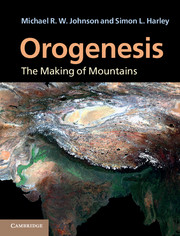Book contents
- Frontmatter
- Contents
- Preface
- Acknowledgments
- Geological timescale
- 1 Major features of the Earth and plate tectonics
- 2 Driving mechanisms for plates, slab retreat and advance, and a cause of orogenesis
- 3 Physical and chemical principles: rock deformation, isostasy, geochronology and heat production in the lithosphere
- 4 Large-scale features of orogens: thrusts and folds
- 5 Evolution of orogens
- 6 Lateral spreading of orogens: foreland propagation, channel flow and weak zones in the crust
- 7 Metamorphism in orogeny
- 8 The erosion and exhumation of mountains
- 9 Sedimentary history of the foredeep basins
- 10 Deep structure, mountain support and phase changes
- 11 Mountains and climate
- 12 Secular change in orogeny
- References
- Index
- Plate section
- References
11 - Mountains and climate
Published online by Cambridge University Press: 05 June 2012
- Frontmatter
- Contents
- Preface
- Acknowledgments
- Geological timescale
- 1 Major features of the Earth and plate tectonics
- 2 Driving mechanisms for plates, slab retreat and advance, and a cause of orogenesis
- 3 Physical and chemical principles: rock deformation, isostasy, geochronology and heat production in the lithosphere
- 4 Large-scale features of orogens: thrusts and folds
- 5 Evolution of orogens
- 6 Lateral spreading of orogens: foreland propagation, channel flow and weak zones in the crust
- 7 Metamorphism in orogeny
- 8 The erosion and exhumation of mountains
- 9 Sedimentary history of the foredeep basins
- 10 Deep structure, mountain support and phase changes
- 11 Mountains and climate
- 12 Secular change in orogeny
- References
- Index
- Plate section
- References
Summary
The effects that mountain building may have on global climates and climate change have received considerable attention in recent years. However, the jury is still out on whether a direct causal link has been established between mountain building and climate or climate change, or at least the degree of influence of the one on the other. Many other factors are involved, not least the amount of CO2 in the Earth's atmosphere. There is agreement that the proposition calls for not only high mountains but also ones covering a large area of the Earth's surface. Climatic modelling has emphasised that in order to influence climate a huge area of high ground is needed, and the modellers consider that the Alps or Himalaya are not big enough, although they may well disrupt a north–south air flow and thereby cause local climatic effects.
Mountains influence climate because they are obstacles to air circulation. Additionally, they are sources of elevated latent heat and they change the water exchanges between continental surfaces and the atmosphere. In this chapter there is no room for an expansive account of this topic, but we will highlight some features and in particular enter the discussion of the role of orogenesis in changing the climate in southern Asia. Most of this chapter is devoted to the ongoing controversies surrounding the hypothesis that the rise of the Tibetan Plateau influenced and strengthened the monsoon in the late Miocene.
- Type
- Chapter
- Information
- OrogenesisThe Making of Mountains, pp. 304 - 321Publisher: Cambridge University PressPrint publication year: 2012
References
- 2
- Cited by



